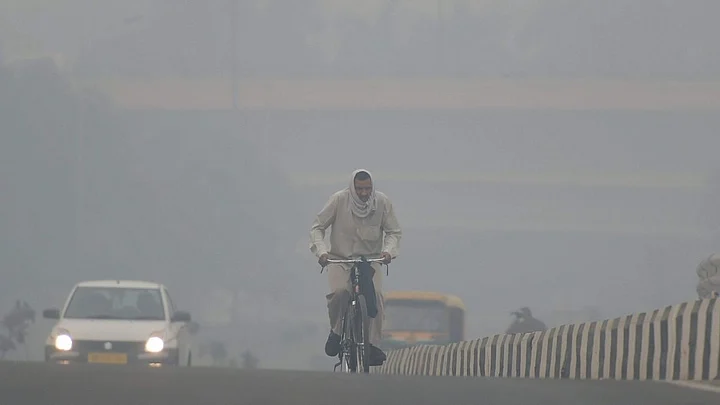The layer of smog over Delhi-NCR intensified on Friday, 12 November, lowering visibility to 200 metres at several places in the region as the national capital continues to suffer hazardous pollution levels post-Diwali.
The 24-hour average Air Quality Index (AQI) was pushed to 471 by 4 pm on Friday, from 411 on Thursday, 11 November, news agency PTI reported.
Over 4,000 farm fires accounted for 35 percent of Delhi's pollution on Friday and played a major role in the worsening AQI.
Meanwhile, the Central Pollution Control Board (CPCB) has advised people to avoid going outdoors in view of severe air pollution in Delhi. It also directed the state government and private offices to reduce vehicle usage by at least 30 percent by working from home, carpooling, and optimising their field activities.
Delhi Residents Breathe Worst Air in November
Every year, residents of the Delhi-NCR breathe the worst air between 1 and 15 November, as per an analysis by the Delhi Pollution Control Committee (DPCC). Six of the last eight days after Diwali have recorded severe air quality.
An AQI between zero and 50 is considered "good", 51 and 100 "satisfactory", 101 and 200 "moderate", 201 and 300 "poor", 301 and 400 "very poor", and 401 and 500 "severe".
The 24-hour average concentration of lung-damaging fine particles known as PM2.5 in Delhi-NCR crossed the 300 mark around midnight, according to the Central Pollution Control Board (CPCB).
The 24-hour average concentration of PM2.5 increased to 381 micrograms per cubic metre at 4 pm on Friday.
This is more than six times the safe limit of 60 micrograms per cubic metre.
Meanwhile, the PM10 level was recorded at 577 micrograms per cubic metre.
As per the Graded Response Action Plan (GRAP), the air quality will be in the emergency category if the PM2.5 and PM10 levels remain above 300 micrograms per cubic metre and 500 micrograms per cubic metre respectively for 48 hours or more.
Further, Dr VK Soni, a part of the sub-committee on GRAP, which convened for the seventh meeting on 12 November, informed that the meteorological conditions are highly unfavourable for dispersion of pollutants till 18 November due to low wind speed and calm conditions during the night.
Moreover, Dr Soni, added that stubble contribution is likely to remain high due to north westerly winds and increased stubble burning.
Meanwhile, Centre for Science and Environment (CSE) had said on Wednesday, 10 November, that the current layer of smog is a public health emergency and could be the longest in four years.
In another report by CSE, it was pointed out that vehicles accounted for more than 50 percent of Delhi's pollution during the early phase of this year's winter, from 24 October to 8 November, PTI reported.
The share of farm fires in Delhi's pollution had increased to 48 percent on Sunday, 7 November, the highest since 5 November 2018, when it was recorded at 58 percent.
Last year, the share of stubble burning in Delhi's pollution had peaked at 42 percent on 5 November.
(With inputs from PTI.)
